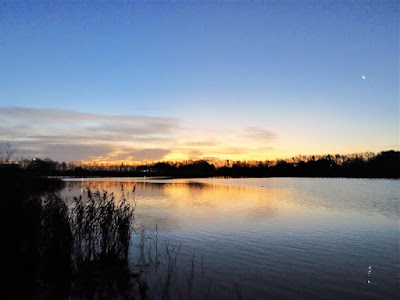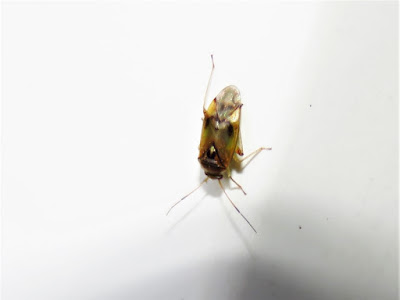Priorslee Lake and The Flash
5.0°C > 7.0°C: Clearing after overnight rain with very few clouds. Light S breeze. Very good visibility.
Sunrise: 08:19 GMT
* = a photo from today.
More or less back to normal this morning.
Priorslee Lake: 06:45 – 09:30
(256th visit of the year)
Very little ice remaining – c.10%?
Bird notes:
- A trio of Mute Swans flew steadily West at 07:50 with the resident cob raising his wings in threat. Against the light it was hard to be sure but I think one adult and two cygnets.
- Four small ducks, not Tufties and presumed Common Teal, departed c.07:15.
- At least 500 gulls either roosted or arrived under cover of darkness and were present by 07:00. Identified as best I could, against the lightening sky to the East as they departed, they seemed to comprise c.100 Black-headed Gulls with all the rest being unidentified large gulls. Very few gulls of any species were seen later.
- I did not hear a Cetti's Warbler but an appropriately-sized bird was noted flying between patches of reeds along the North side pre-dawn.
Birds noted flying over here:
- 38 Canada Goose: 22 outbound in two groups; 16 inbound together
- 2 Greylag Geese: outbound together
- 3 Mute Swans: probably adult and two cygnets
- 2 (1♂) Goosanders
- 2 Stock Doves
- 9 Wood Pigeons
- 21 Lesser Black-backed Gull
- 21 Jackdaws
- 12 Rooks
- 3 Fieldfares
- 2 Redwings
- 2 Siskins
Warblers noted:
- 1 possible Cetti's Warbler: no calls or song: see notes
Birds noted leaving roosts around the lake:
- 4 Redwings
- 1 Reed Bunting
Counts from the lake area:
- 20 Canada Goose: 14 of these departed in two groups
- 2 + 4 (1 brood) Mute Swans
- 7 (4♂) Gadwall again
- 11 (8♂) Mallard
- 4 (?♂) Common Teal: see notes
- *3 (2♂) Pochard
- 47 (>19♂) Tufted Duck: see notes
- 13 Moorhens
- 196 Coots
- 1 Great Crested Grebe
- >100 Black-headed Gulls
- 2 Herring Gulls
- 10 Lesser Black-backed Gulls
- c.400 large gulls pre-dawn
- 1 Cormorant
Noted on / around the street lamp poles pre-dawn:
- *4 Winter Moths (Operophtera brumata)
- *2 Scarce Umber moths (Agriopis aurantiaria)
- *2 larva
- *1 gnat sp.
- *2 globular springtails
- *1 Common Pygmy Woodlouse (Trichoniscus pusillus agg.)
- 1 stretch spider Tetragnatha sp.
Noted later:
- *Hazel (Corylus avellana) catkins
- 3 Grey Squirrels
5.0°C > 7.0°C: Clearing after overnight rain with very few clouds. Light S breeze. Very good visibility.
Sunrise: 08:19 GMT
* = a photo from today.
More or less back to normal this morning.
Priorslee Lake: 06:45 – 09:30
(256th visit of the year)
Very little ice remaining – c.10%?
Bird notes:
- A trio of Mute Swans flew steadily West at 07:50 with the resident cob raising his wings in threat. Against the light it was hard to be sure but I think one adult and two cygnets.
- Four small ducks, not Tufties and presumed Common Teal, departed c.07:15.
- At least 500 gulls either roosted or arrived under cover of darkness and were present by 07:00. Identified as best I could, against the lightening sky to the East as they departed, they seemed to comprise c.100 Black-headed Gulls with all the rest being unidentified large gulls. Very few gulls of any species were seen later.
- I did not hear a Cetti's Warbler but an appropriately-sized bird was noted flying between patches of reeds along the North side pre-dawn.
Birds noted flying over here:
- 38 Canada Goose: 22 outbound in two groups; 16 inbound together
- 2 Greylag Geese: outbound together
- 3 Mute Swans: probably adult and two cygnets
- 2 (1♂) Goosanders
- 2 Stock Doves
- 9 Wood Pigeons
- 21 Lesser Black-backed Gull
- 21 Jackdaws
- 12 Rooks
- 3 Fieldfares
- 2 Redwings
- 2 Siskins
Warblers noted:
- 1 possible Cetti's Warbler: no calls or song: see notes
Birds noted leaving roosts around the lake:
- 4 Redwings
- 1 Reed Bunting
Counts from the lake area:
- 20 Canada Goose: 14 of these departed in two groups
- 2 + 4 (1 brood) Mute Swans
- 7 (4♂) Gadwall again
- 11 (8♂) Mallard
- 4 (?♂) Common Teal: see notes
- *3 (2♂) Pochard
- 47 (>19♂) Tufted Duck: see notes
- 13 Moorhens
- 196 Coots
- 1 Great Crested Grebe
- >100 Black-headed Gulls
- 2 Herring Gulls
- 10 Lesser Black-backed Gulls
- c.400 large gulls pre-dawn
- 1 Cormorant
Noted on / around the street lamp poles pre-dawn:
- *4 Winter Moths (Operophtera brumata)
- *2 Scarce Umber moths (Agriopis aurantiaria)
- *2 larva
- *1 gnat sp.
- *2 globular springtails
- *1 Common Pygmy Woodlouse (Trichoniscus pusillus agg.)
- 1 stretch spider Tetragnatha sp.
Noted later:
- *Hazel (Corylus avellana) catkins
- 3 Grey Squirrels
A duck Pochard looks on while a drake shakes himself after a bathe.
Having seen how it is done she follows suit.
A less common moth is this Scarce Umber (Agriopis aurantiaria), though it is nowhere near as scarce as the vernacular name suggests. Although it does not look like it here it is significantly larger than a Winter Moth.
The other Scarce Umber moth. This one is covered in dew but neither of them were well-marked. The wing markings are very variable in this, and allied, species. These are my first here this year (I saw one at The Flash about 10 days ago). It brings my 2022 moth total here to 94 (I logged 134 species last year).
One of two larvae I found this morning. This one is crawling across metal band that holds the cover of the electrical supply on to the base of the street lamp pole. I am fairly certain it is a sawfly larva but I cannot be more specific.
Here is the other larva – the green semi-transparent blob at the top. From another sawfly species I think. Only when I looked at the photo did I notice two small interlopers at the bottom. On the left a species of gnat and on the right one of the globular springtails.
This is a different globular springtail. My camera does not have enough resolution for me to identify which species it might be.
What we have here is a Common Pygmy Woodlouse (Trichoniscus pusillus agg.). The 'agg.' stands for 'aggregate' and indicates that more than one closely-related species is involved. I read that males are separable by detailed examination of their genitalia; the females are not separable. Since I can't tell a male woodlouse from a female that is none too helpful.
Hazel (Corylus avellana) catkins. Can Spring be far away? Probably.
Plane of the day: this one nearly got away as it is a very quiet aircraft that I did not initially hear above the M54 traffic noise. It is a Tecnam P2006T registered to the telecommunications company 3GRComm at a Hereford address. Tecnam builds this four-seater aircraft in Italy There have only been fourteen of these aircraft registered in the UK and this is one of eight that are active.
(Ed Wilson)
------------------------------------------------------------------------------------------------------
The Flash: 09:35 – 10:37
(247th visit of the year)
Still about 50% iced over.
Bird notes:
- Initially seven Goosanders (two drakes). A loose group of seven more came from the North with four of them (two more drakes) settling on the water. Not sure of the sex of the three that flew on. Later a drake departed.
Noted flying over:
- 3 (?♂) Goosanders: see notes
- 3 Lesser Black-backed Gulls
- 1 Cormorant
- 1 Sparrowhawk
Noted on / around the water
- 8 Canada Geese
- 2 + 4 (1 brood) Mute Swans
- 60 (39♂) Mallard
- 1 all-white duck (Peking(?) Duck)
- 3 (2♂) Pochard
- 14 (7♂) Tufted Duck
- 12 (5♂) Goosanders: see notes
- 21 Moorhens
- 50 Coots
- 44 Black-headed Gulls
- 2 Lesser Black-backed Gulls
- 3 Grey Herons
Of note
Nothing else other than one small unidentified fly noted around the Ivy bank.
Well I was a long way away but could not resist this shot of a drake Goosander with bright feet akimbo as it prepares to splash down. The duck has already crashed in to the water.
A few seconds later it shows all its sixteen tail feathers.
A bit of a cheat. I found this on my door when I got home. It looks to be a Common Flower Bug (Anthocoris nemorum) that has survived the freeze and started exploring again. This species is apparently active all year.
Another cheat. A tiny beetle on my anorak is also taking advantage of the warmer conditions. It is probably one of the Chrysomelidae (Leaf and Flea Beetles). There are several that look like this and I have no idea how to tell them apart.
(Ed Wilson)
------------------------------------------------------------------------------------------------------
On this day can be found via the yearly links in the right-hand column.
Sightings from previous years without links are below
2013
Priorslee Lake
5 Gadwall
2 Teal
6 Pochard
94 Tufted Ducks
10 Goosander
1 Water Rail
229 Coots
2 Fieldfare
85 Redwings
(Ed Wilson)
The Flash
1 Little Grebe
151 Tufted Ducks
1 Greater Scaup
2 Goosanders
(Ed Wilson)
Trench Lock Pool
1 Little Grebe
1 Shoveler
1 Pochard
95 Tufted Duck
133 Coots
54 Black-headed Gulls
4 Lesser Black-backed Gull
1 Yellow-legged Gull
7 Herring Gulls
(Ed Wilson)
Horsehay Pool
Iceland Gull
Yellow-legged Gull
(Tom Lowe)
2010
Priorslee Lake
1 Mallard x Pintail
c.200 Black-headed Gulls
1 Common Gull
110 Lesser Black-backed Gulls
6 Herring Gulls
1 Redwing
4 Fieldfare
5 Siskins
(Ed Wilson)
2009
Priorslee Lake
Little Grebe
Black-necked Grebe
Water Rail
>3000 Black-headed Gulls
28 Swans
2 Gadwall
52 Pochard
112 Tufted Ducks
287 Coots
10 Redwings
199 Jackdaws
6 Siskins
(Ed Wilson)
2006
Priorslee Lake
31 Pochard
33 Tufted Ducks
c.400 Black-headed Gulls
c.2800 Lesser Black-backed Gulls
31 Herring Gulls
1 Yellow-legged Gull
18 Pied Wagtails
2 Redpolls
7 Reed Buntings
(Martin Adlam)















